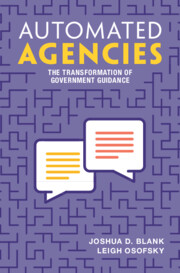Refine search
Actions for selected content:
2860 results in Computing and Society
7 - The Hidden Costs of Automated Legal Guidance
-
- Book:
- Automated Agencies
- Published online:
- 03 April 2025
- Print publication:
- 10 April 2025, pp 121-143
-
- Chapter
- Export citation
4 - Simplexity in Automated Legal Guidance
-
- Book:
- Automated Agencies
- Published online:
- 03 April 2025
- Print publication:
- 10 April 2025, pp 71-94
-
- Chapter
- Export citation
6 - How Automated Legal Guidance Helps Agencies and the Public
-
- Book:
- Automated Agencies
- Published online:
- 03 April 2025
- Print publication:
- 10 April 2025, pp 110-120
-
- Chapter
- Export citation
3 - Simplexity
-
- Book:
- Automated Agencies
- Published online:
- 03 April 2025
- Print publication:
- 10 April 2025, pp 57-70
-
- Chapter
- Export citation
1 - The Rise of Automated Customer Service
-
- Book:
- Automated Agencies
- Published online:
- 03 April 2025
- Print publication:
- 10 April 2025, pp 12-25
-
- Chapter
- Export citation
5 - View from the Inside
-
- Book:
- Automated Agencies
- Published online:
- 03 April 2025
- Print publication:
- 10 April 2025, pp 95-109
-
- Chapter
- Export citation
Dedication
-
- Book:
- Automated Agencies
- Published online:
- 03 April 2025
- Print publication:
- 10 April 2025, pp v-vi
-
- Chapter
- Export citation

Automated Agencies
- The Transformation of Government Guidance
-
- Published online:
- 03 April 2025
- Print publication:
- 10 April 2025
8 - E-Commerce Platforms as Product Merchants and Sellers
- from Part II - The Implications of Emerging Product Design and Business Models
-
-
- Book:
- The Cambridge Handbook of Emerging Issues at the Intersection of Commercial Law and Technology
- Published online:
- 08 February 2025
- Print publication:
- 20 February 2025, pp 171-194
-
- Chapter
- Export citation
9 - 3D Printing
- from Part II - The Implications of Emerging Product Design and Business Models
-
-
- Book:
- The Cambridge Handbook of Emerging Issues at the Intersection of Commercial Law and Technology
- Published online:
- 08 February 2025
- Print publication:
- 20 February 2025, pp 195-214
-
- Chapter
- Export citation
6 - Quantum Privacy
- from Part I - Contemporary Technological Developments
-
-
- Book:
- The Cambridge Handbook of Emerging Issues at the Intersection of Commercial Law and Technology
- Published online:
- 08 February 2025
- Print publication:
- 20 February 2025, pp 128-147
-
- Chapter
- Export citation
10 - The Right to Repair, Intellectual Property, Exhaustion, and Preemption
- from Part II - The Implications of Emerging Product Design and Business Models
-
-
- Book:
- The Cambridge Handbook of Emerging Issues at the Intersection of Commercial Law and Technology
- Published online:
- 08 February 2025
- Print publication:
- 20 February 2025, pp 215-229
-
- Chapter
- Export citation
2 - The Challenges of Technological Property
- from Part I - Contemporary Technological Developments
-
-
- Book:
- The Cambridge Handbook of Emerging Issues at the Intersection of Commercial Law and Technology
- Published online:
- 08 February 2025
- Print publication:
- 20 February 2025, pp 34-50
-
- Chapter
- Export citation
Contributors
-
- Book:
- The Cambridge Handbook of Emerging Issues at the Intersection of Commercial Law and Technology
- Published online:
- 08 February 2025
- Print publication:
- 20 February 2025, pp xv-xxii
-
- Chapter
- Export citation
12 - Ending Smart Data Enclosures
- from Part II - The Implications of Emerging Product Design and Business Models
-
-
- Book:
- The Cambridge Handbook of Emerging Issues at the Intersection of Commercial Law and Technology
- Published online:
- 08 February 2025
- Print publication:
- 20 February 2025, pp 258-283
-
- Chapter
- Export citation
Part I - Contemporary Technological Developments
-
- Book:
- The Cambridge Handbook of Emerging Issues at the Intersection of Commercial Law and Technology
- Published online:
- 08 February 2025
- Print publication:
- 20 February 2025, pp 1-168
-
- Chapter
- Export citation
1 - Non-fungible Tokens in Commercial Transactions
- from Part I - Contemporary Technological Developments
-
-
- Book:
- The Cambridge Handbook of Emerging Issues at the Intersection of Commercial Law and Technology
- Published online:
- 08 February 2025
- Print publication:
- 20 February 2025, pp 3-33
-
- Chapter
- Export citation
Index
-
- Book:
- The Cambridge Handbook of Emerging Issues at the Intersection of Commercial Law and Technology
- Published online:
- 08 February 2025
- Print publication:
- 20 February 2025, pp 457-480
-
- Chapter
- Export citation
15 - How Smart Are Smart Readers? LLMs and the Future of the No-Reading Problem
- from Part III - Contracting and Dispute Resolution
-
-
- Book:
- The Cambridge Handbook of Emerging Issues at the Intersection of Commercial Law and Technology
- Published online:
- 08 February 2025
- Print publication:
- 20 February 2025, pp 336-374
-
- Chapter
- Export citation
19 - Evolution and Emerging Issues in Consumer Online Dispute Resolution (ODR)
- from Part III - Contracting and Dispute Resolution
-
-
- Book:
- The Cambridge Handbook of Emerging Issues at the Intersection of Commercial Law and Technology
- Published online:
- 08 February 2025
- Print publication:
- 20 February 2025, pp 436-456
-
- Chapter
- Export citation
